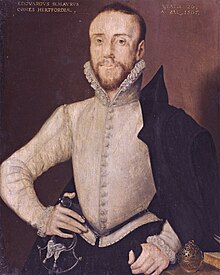Lady Katherine Grey
Arrested after the Queen was informed of their clandestine marriage, Katherine (as Lady Hertford) lived in captivity until her death, having borne two sons in the Tower of London.Katherine Grey's maternal grandparents were Charles Brandon, 1st Duke of Suffolk, and Mary Tudor, Dowager Queen of France, youngest surviving daughter of Henry VII and Elizabeth of York.Without royal assent, the two were married in December 1560 during a secret ceremony[13] at Lord Hertford's house in Cannon Row, where Lady Jane Seymour was the sole witness.As Dudley's room adjoined the Queen's chambers, he was afraid they might be overheard or that he might be caught with a visibly pregnant woman at his bedside, and tried to get rid of Katherine as soon as he could.The marriage also upset Anglo-Scottish diplomacy, as the possibility of a union between Lady Katherine and the Earl of Arran, a young and unstable nobleman with a strong claim to the Scottish throne, had thereby been removed as an option.[20] Queen Elizabeth imprisoned Lady Katherine in the Tower of London, where Edward Seymour (Lord Hertford) was sent to join her on his return to England.[22] While imprisoned in the Tower, Katherine gave birth to two sons: In 1562, the marriage was annulled and the Seymours were censured as fornicators for "carnal copulation" by the Archbishop of Canterbury.

MiniatureLevina TeerlincBradgate ParkLeicesterCockfield HallYoxfordSuffolkSalisbury CathedralHenry Herbert, Lord HerbertEdward Seymour, 1st Earl of HertfordEdward Seymour, Lord BeauchampHenry Grey, 1st Duke of SuffolkLady Frances BrandonLady Jane GreyHenry VIIIElizabeth I of Englandclandestine marriageTower of LondonLady Mary GreyCharles Brandon, 1st Duke of SuffolkMary Tudor, Dowager Queen of FranceHenry VIIElizabeth of YorkgrandmotherEnglish thronePrince EdwardLady MaryLady ElizabethPrincess MargaretMary, Queen of ScotsHenry, Lord Herbertheir apparentWilliam Herbert, 1st Earl of PembrokeKing Edward VIJohn Dudley, 1st Duke of NorthumberlandLetters PatentLord Guildford DudleyBaynard's CastleannulmentDuke of SuffolkWyatt's RebellionLord HertfordLady Jane SeymourDuke of Somersetrestyledroyal assentCannon Rowsole witnessThomas CecilSir William Cecilgrand tourEuropedocumenttuberculosisroyal courtIpswichBess of HardwickRobert DudleyEdward, Lord BeauchampEarl of ArranJohn HalesSir Edward WarnerLieutenant of The TowerEdward SeymourCatesbySt. Margaret's Church, Westminstermonument with effigiesArchbishop of CanterburyillegitimateWilliam PetreIngatestone HallGosfield HallconsumptionChurchHouse of TudorMargaret TudorMary TudorCharles BrandonEdward VIMary IElizabeth IJames V of ScotlandMargaret DouglasFrances BrandonHenry GreyHenry StuartJane GreyMary GreyQueen Elizabeth IIWilliam Seymour, 2nd Duke of SomersetCharles Boyle, 3rd Viscount DungarvanCharles Boyle, 2nd Earl of BurlingtonRichard Boyle, 3rd Earl of BurlingtonCharlotte Cavendish, Marchioness of HartingtonDorothy Bentinck, Duchess of PortlandLord Charles BentinckCharles Cavendish-Bentinck (priest)Cecilia Bowes-Lyon, Countess of Strathmore and KinghorneQueen Elizabeth The Queen MotherElizabeth IIThomas RandolphLee, SidneyDictionary of National BiographyIves, Eric